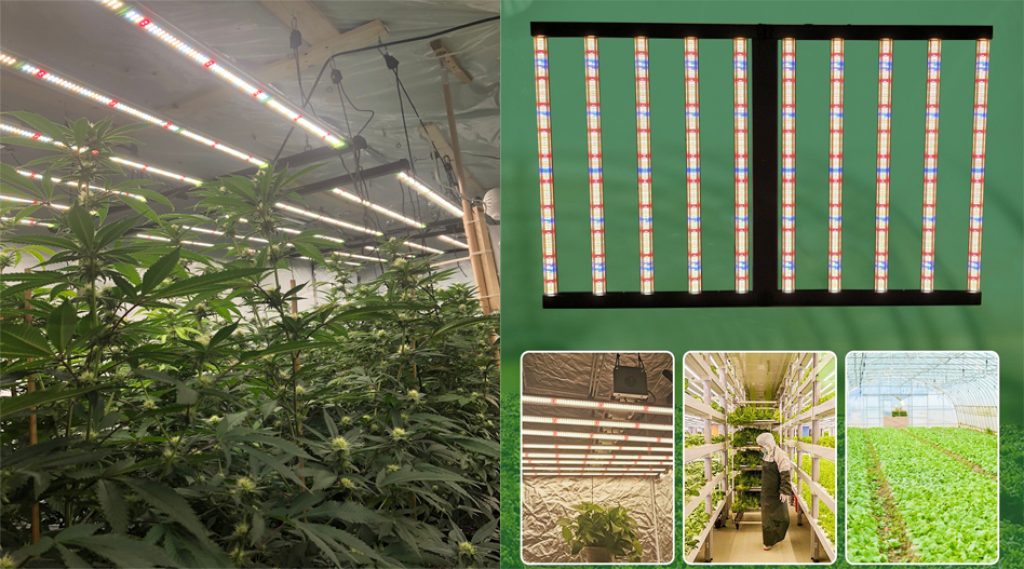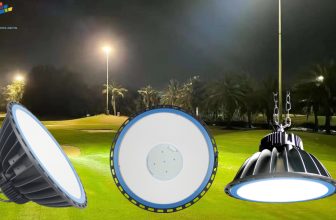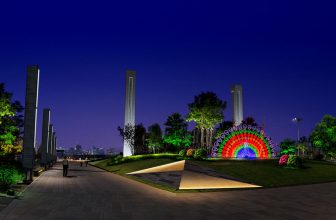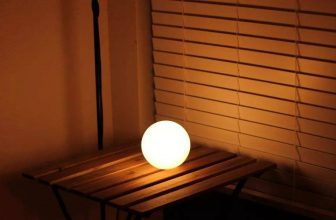At present, there are several viewpoints on this issue:
1) The solar spectrum is the spectrum with the highest photosynthetic efficiency, and plant lamps should be matched with a similar solar spectrum.
2) Plants all over the world grow and evolve under sunlight, and the solar like spectrum is the best spectrum for plant lamps.
3) LED Grow Lights with solar spectral characteristics can help plants grow the best.
Firstly, clarify a viewpoint.
The solar spectrum is the plasma spectrum with the most complete spectral composition.
Next, we will provide answers to the above three questions.
1) For the photosynthesis of plants, the solar spectrum is not the spectrum with the highest photosynthetic efficiency. Therefore, we need to study spectral techniques.
2) Plants around the world grow to adapt to sunlight at different latitudes, climates, and geographical conditions. For plants, there is no best spectrum, only the most suitable.
3) Compared with LED light sources, the biochemical and nutritional indicators of plant growth in artificial lighting environments are not inferior at all compared to sunlight, and some indicators are controlled better than sunlight.
To learn the spectroscopic techniques of bio optics, the first step is to have a clear understanding of the following:
Photosynthesis is synonymous with the absorption of light energy by plants.
Photosynthesis is a way in which light energy is converted into matter.
Einstein’s mass energy equation states that energy is matter, and matter is also energy.
Light has no color, and different wavelengths of light are only differences in photon energy.
Next, let’s explain why?
1.The energy content of sunlight
Sunlight is the radiation (electromagnetic) energy of the sun. To provide light and heat to the Earth, and to provide energy for photosynthesis. This radiation energy is essential for the biological environment and human metabolism. The solar radiation spectrum has three related band ranges, namely: ultraviolet, visible light (PAR: 400-700 nm), and infrared.
Note here that Far Red and Infrared light are not the same thing.
56% of the energy of solar radiation reaching the Earth can reach the surface of the Earth. However, some of the light is reflected by snow or other bright ground, so only 48% of the energy can be absorbed by land or water (note that the water surface also reflects some solar radiation)
In the sunlight that reaches the Earth’s surface, infrared radiation accounts for 49.4% and visible light accounts for 42.3%. Ultraviolet radiation accounts for only over 8% of the total solar radiation. Each of these bands has a different impact on the environment.
2.Spectral requirements for photosynthesis
The wavelength range in which sunlight can provide photosynthesis is called the effective radiation PAR for photosynthesis, with a wavelength range of 400-700 nm. At present, science has not overturned this universal cognition.
UV-C includes wavelengths between 100-280 nm. This radiation range only accounts for 0.5% of all solar radiation, but it causes the greatest damage to living organisms. However, most shortwave radiation is absorbed by stratospheric gases (ozone) and rarely reaches the surface.
Infrared and ultraviolet light are located on both sides of the spectral PAR.
The wavelength of infrared radiation is>760 nm, providing 49.4% of solar energy. Infrared radiation is easily absorbed by water and carbon dioxide molecules and converted into thermal energy. The wavelength of infrared light generates heat by exciting and absorbing electrons in their substances. Therefore, infrared radiation is responsible for warming the Earth’s surface. Infrared light reflects more than ultraviolet or visible light due to its longer wavelength. This reflection allows infrared radiation to transfer heat between the surface, water, and air.
In addition to UVC, only UVA and UVB are left to reach the Earth’s surface, and the absorption response of plants to this part of light is related to plant characteristics. It is still under research, and one thing can be determined that the correlation between photosynthesis and this part of light energy is extremely low, or not.
3.Quantum efficiency of photosynthesis
Photosynthesis mainly occurs in the leaves of plants, which contain the highest concentration of chloroplasts. The leaves of plants have tiny pores that absorb carbon dioxide from the surrounding air.
Chloroplasts contain chlorophyll, and the energy converted into chemical energy by chloroplasts is absorbed by sunlight. The other two components required for photosynthesis are carbon dioxide and water. The combination of these three substances provides energy for the photosynthesis process, thereby producing glucose and oxygen, which provide available energy for plant growth.
The maximum efficiency of sunlight on photosynthesis can be explained by quantitative values.
For the PAR band of light energy, the average wavelength is 570 nm; Therefore, the amount of light energy used during photosynthesis is approximately 50 cal per nanometer.
Usually, the number of photons absorbed by each released oxygen molecule is called the quantum requirement.
The quantum requirement is usually 8-12 photons (PAR energy), and we calculate it using 9 photons. The photon energy used is 9 × 50=450 cal, which means that 450 cal is required for each released oxygen molecule.
The energy stored for each release of oxygen is 117 cal, and the estimated maximum energy efficiency for photosynthesis is 117/450=0.26, which is 26%. This is the theoretical maximum value for converting light energy into matter.
In fact, there are various factors that reduce this efficiency, such as temperature, humidity, light suppression, energy conversion efficiency of assimilation, Calvin cycle efficiency, water, nutrients, etc. Considering various factors, the maximum recorded typical photosynthetic efficiency is about 12%, which means that the PAR part of sunlight can store up to 12% of energy efficiency in plants through photosynthesis.
The quantum efficiency of photosynthesis under artificial light with spectral technology is much higher than that of solar spectrum, which can be calculated.
Photosynthesis only utilizes a small amount of incident sunlight (PAR) to convert into organic compounds, and the average net carbon sequestration efficiency of terrestrial plants is only 3.3%, with most plants having low utilization efficiency of sunlight.
The conclusion is that the photosynthetic efficiency of the solar spectrum is lower than that of the artificially mixed plant lamp spectrum, because a lot of energy is wasted in the spectral components.
4.The nutritional composition and taste of edible parts of plants
Some people may argue that the nutrition and taste of plants under the solar spectrum are good. I believe those who hold this view must provide reproducible experimental data, such as biochemical and nutritional indicators. From the mechanism of plant absorption of light energy, there is no difference in the characteristics of plants under the two energy supplies of sunlight and artificial light. The only difference is the time integration effect and stress effect.
Under the same planting environment and light level, there will be no difference in the nutritional composition and taste of the edible parts of plants, because plants cannot distinguish between sunlight and artificial light. Comparing fast growing plants with slow growing plants is not scientific in itself, as some substances that affect the taste of plants require time effects to accumulate.
5.It is necessary to follow scientific experimental methods to explain
For the comparative study of photosynthesis between sunlight and artificial light, the more systematic study is the experiment of American scientist Mockley. For this part of knowledge, you can see the WeChat public: fsourled. There are research articles about Mockley, which can be found by searching the official account.
Mockley’s research indicates that the efficiency of plants in utilizing light energy is reflected in their spectral morphology, which is the basis for designing artificial light spectra. Spectral technology provides the lowest energy consumption spectral ratio (formula), which is not based on solar spectra, but on the properties of plants in terms of light energy demand.
6.The purpose of spectral technology research on plants
The essence of any technological advancement is to improve application efficiency, and plant artificial lighting technology is also for this purpose. In greenhouse and plant factory environments, insufficient natural light energy supply has led to the application of artificial lighting. Artificial lighting proposes spectral technology based on the absorption properties of plants to light. Through application, it is found that artificial lighting can completely replace natural light. At the same time, planting efficiency is greatly improved, which is in line with the industrial process transformation of agricultural planting.
The purpose of spectral technology research is to improve planting efficiency, so it is necessary to study spectral technology based on the properties of plant absorption of light energy, rather than based on solar spectra.
The mechanism of photosynthesis, like other mechanisms in plants, has its own processes of occurrence, growth, and aging. The photosynthetic rate is relatively low in the early stages of development; Higher after growth and stable for a period of time; Decline during aging. The physiological state and external conditions of plants have a significant impact on the duration of each stage of photosynthetic rate and the level of photosynthetic rate. When the demand for photosynthetic products increases in other parts of the plant, the photosynthetic rate often increases. On the contrary, when the utilization of photosynthetic products is slow or the output is blocked, the photosynthetic rate will gradually decrease.
The spectral technology of artificial lighting can effectively meet the absorption characteristics of plants and provide maximum planting efficiency. This is another purpose of the research on plant light spectral technology.
7.Plant Lamp Spectral Technology Advocates Fully Utilizing Sunlight
The application of plant lamp spectroscopy technology has never excluded the full utilization of sunlight, and their relationship is more closely linked under the market economy effect. An excellent spectroscopic technique is a technical performance that maximizes the utilization of sunlight. Here, we reiterate a principle: There is no best spectrum, only the most suitable one. From the perspective of controllable technology, plant lamp spectroscopy technology and planting process spectroscopy technology bear the historical mission of facility agriculture. To further understand the core technology of plant lamp spectroscopy technology – planting process spectroscopy technology, please follow the release of Wandan Lighting.










